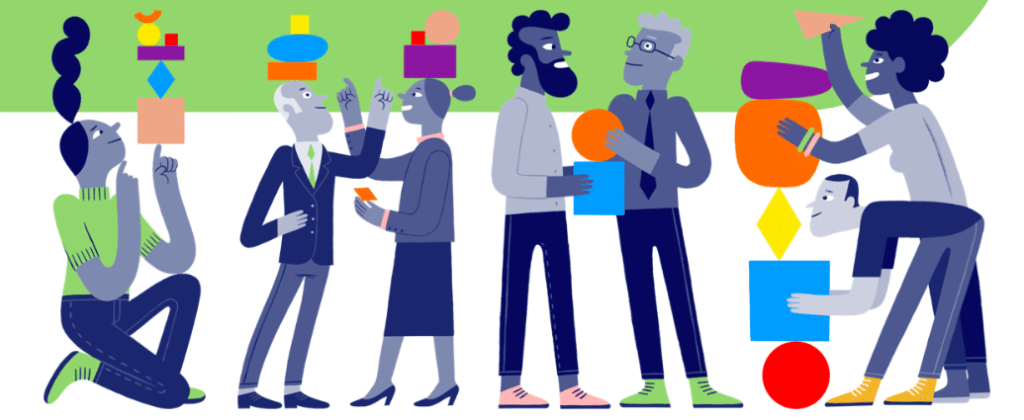
Bids For Connection, Personality Science, and Leadership Communication
Share viaRelationships are built on communication that affirms each person’s unique perspective and provides the kind of positive attention they need. Dr. John Gottman is a well-known relationship researcher who studied what predicts if a marriage will succeed or fail. He called these exchanges “Bids for Connection.” How we respond to bids can make or break a relationship. Gottman’s research, summarized in this article, has been applied far beyond marriage relationships.
In this post, I share a powerful framework for recognizing and responding to bids that you can use to build rapport, trust, and impact in any relationship, with all different personality types.
How Do You Respond To a Bid for Connection?
When someone makes a bid for connection, there are three main ways we can respond:
- Turning towards (acknowledging the bid)
- Turning away (ignoring or missing the bid)
- Turning against (rejecting the bid in an argumentative or belligerent way)
Turning towards the bid is the most effective for building strong relationships since it acknowledges the invitation and affirms the person making the bid.
Gottman has outlined 14 bids for emotional connection. You can see the list here.
That’s a lot to keep track of! How do you know which one is being offered, how to respond, or which one will work best? Thankfully, personality science makes it simple.
Personality and Bids for Connection
Did you know that bids for connection are correlated with personality type? Different personalities prefer different types of connection. Dr. Taibi Kahler, a renowned behavioral psychologist and creator of the Process Communication Model®, identified modes of connection that apply not just to couples, but to any person who is communicating with another person. These modes of connection are called Channels of Communication. Channels of Communication are a powerful tool for any leader, parent, coach, or educator because they provide insight into how different people communicate, and how to respond in the most effective way to turn toward the bid.
Four Channels of Communication
Communication occurs when there is an offer and an acceptance in the same channel. – Dr. Taibi Kahler
Channels consist of an offer from one person (Bid), and an acceptance from the other person (Turning toward the bid). Each channel has a different “vibe.” For each example below, the Offer is on the left, and the acceptance is on the right. When we recognize the offer, we can respond with the appropriate response, thereby “turning toward” the other person, affirming their bid, and matching the vibe.
Emotive Channel – Playing

Some personalities prefer playful interactions that are lighthearted and upbeat. They initiate communication by energizing the “Emoter” part of themselves. You can recognize this by the sparkle in their eyes, the smile, and the expressive tone. Their bids are all about getting a reaction out of others. So the best way to turn toward the bid is to match their energy, show a reaction and play with them. Here are some examples; offer followed by acceptance.
“Hey, how about the Kansas City Chiefs!”
“I know, right! They are killing it!”
or
“I love your new shoes.”
“Thanks. I love them too.”
Nurturative Channel – Caring

Some personalities prefer nurturing interactions that show care, concern, and empathy. They initiate communication by energizing the “Comforter” part of themselves. You can recognize this by the warmth in their tone, their concern for your feelings, and the compassion in their voice. Their bids are all about inviting others to feel cared for and unconditionally worthwhile. So the best way to turn toward the bid is to accept their gift of caring and express your appreciation. Here are some examples;
“I really appreciate you.”
“Thanks so much. I can feel it.”
or
“I hope your daughter is feeling better.”
“Thank you for caring.”
Requestive Channel – Asking

Some personalities prefer non-emotional, didactic interactions aimed at exchanging information and opinions. They initiate communication by energizing the “Computer” part of themselves. You can recognize this by their lack of emotion and subdued body language. Their bids are all about asking questions to solicit information and opinions from others. So the best way to turn toward the bid is to give them the information they are asking for or share your opinion about the topic. Here are some examples;
“What time will we finish today?”
“Six o’clock.”
or
“What do you believe is the best response to management?”
“I believe we should let them know our position on this matter.”
Directive Channel – Telling

Believe it or not, some personalities prefer a no-nonsense, directive style of communication. They initiate communication by energizing the “Director” part of themselves. You can recognize this by their firm but non-attacking tone, and their use of imperatives. Their bids are all about directing action by telling people what to do. While this might not be your favorite style, you don’t have to take it personally or get offended. The best way to turn toward the bid is to execute the command without emotion. Here are some examples;
“Tell me where to find the Johnson file.”
“Look in the archives.”
or
“Give me two action steps from our meeting.”
“Finish our sales calls, and suggest one new strategy for the next quarter.”
Tips for Building Connection By Using Channels
- There are just four Channels. See if you can detect which “Part” someone is using to initiate communication; Emoter, Comforter, Computer, or Director.
- Respond by closing the channel. This means mobilizing your own energy to match the person’s invitation. See the four diagrams above for which part is best suited to each invitation. This is how you turn toward the other person’s bid.
- Pay attention to your own comfort, but don’t let it stop you. Each of us has a favorite, preferred channel that is most comfortable. To communicate with others, we might need to use other channels, ones that aren’t as comfortable or familiar. That’s OK. Just because it’s not comfortable doesn’t make it wrong or inauthentic. Tell yourself, “I’m willing to stretch outside my comfort zone because I want to make a connection with the other person.”
- Respond to what you see, not what you think you know. Everyone has a favorite Channel, but they are capable of using any of the four Channels in daily communication. So just when you think you know someone, they might surprise you.
Use Channels To Be a Better Leader
- Build Trust. Turning towards another person’s bid by closing their Channel is one of the best ways to build trust. That’s because it shows them you are willing to meet them where they are and honor their way of communicating. Here’s an article on how to build trust with each of the six PCM personality types. I bet you can figure out which Channel each one prefers.
- Establish Rapport. Whether you are a leader trying to connect with your people, a salesperson trying to connect with a customer, or a teacher trying to connect with your students in the classroom, Channels are one of the most powerful and effective ways to establish rapport.
- Improve Retention and Recall. How you say something often matters more than what you say. People are more likely to pay attention and remember what you say if the information is delivered in their favorite Channel. Try using different Channels to convey the same information and see who responds best. Here’s an example. In this video, I tell the story of the Three Little Pigs in six different ways.
I’ve been teaching Channels as part of PCM training for almost 20 years. Based on feedback from my clients, and my own observations, I believe that Channels are the secret sauce for communication. If you can master this, you are on your way to being a master communicator.
Copyright Next Element Consulting, LLC 2023
Learn How To Communicate With Any Personality Type
Book Your Next Keynote Speaker

Author and Co-founder of Next Element, Dr. Nate Regier is available to speak at your upcoming event.
Submit a Speaker RequestListen to Nate on The Compassionate Accountability Podcast
 Listen to the Podcast
Listen to the Podcast

0 Comments
Add comment